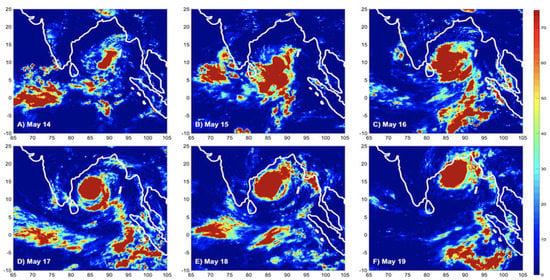The Impact of the Madden–Julian Oscillation on Cyclone Amphan (2020) and Southwest Monsoon Onset
Abstract
1. Introduction
2. Materials and Methods
2.1. Data
2.1.1. Satellite Data
2.1.2. Model Forecasts
2.2. Methods
2.2.1. Ocean Heat Content
2.2.2. Mixed Layer Depth, Isothermal Layer Depth, and Mixed Layer Depth
2.2.3. Bandpass Filtering
3. Results
3.1. Cyclone Overview
3.1.1. Cyclone Track
3.1.2. Multiparameter Analysis
3.2. Impacts on the Bay of Bengal
3.3. Equatorial Processes
3.4. Impact on Southwest Monsoon Onset
4. Discussion
4.1. Cyclogenesis
4.2. Southwest Monsoon Onset
5. Conclusions
Author Contributions
Funding
Acknowledgments
Conflicts of Interest
References
- Smitha, A.; Rao, K.H.; Sengupta, D. Effect of May 2003 tropical cyclone on physical and biological processes in the Bay of Bengal. Int. J. Remote Sens. 2006, 27, 5301–5314. [Google Scholar] [CrossRef]
- Singh, O.P.; Masood, T.; Khan, A.; Rahman, M.S. Has the frequency of intense tropical cyclones increased in the north Indian Ocean? Curr. Sci. 2001, 80, 575–580. [Google Scholar]
- Singh, O.P. Long-term trends in the frequency of severe cyclones of Bay of Bengal: Observations and simulations. Mausam 2007, 58, 59–66. [Google Scholar]
- Yu, L.; McPhaden, M.J. Ocean preconditioning of Cyclone Nargis in the Bay of Bengal: Interaction between Rossby waves, Surface Fresh Waters, and Sea Surface Temperatures. J. Phys. Oceanogr. 2011, 41, 1741–1755. [Google Scholar] [CrossRef]
- Frank, W.M.; Roundy, P.E. The role of tropical waves in tropical cyclogenesis. Mon. Weather Rev. 2006, 134, 2397–2417. [Google Scholar] [CrossRef]
- Climate Monitoring Graphs: IOD Index Time Series. Available online: http://www.bom.gov.au/climate/enso/indices.shtml?bookmark=iod (accessed on 2 August 2020).
- ENSO Outlook. Available online: http://www.bom.gov.au/climate/enso/outlook/ (accessed on 2 August 2020).
- Mahala, B.K.; Nayak, B.K.; Mohanty, P.K. Impacts of ENSO and IOD on tropical cyclone activity in the Bay of Bengal. Nat. Hazards 2015, 75, 1105–1125. [Google Scholar] [CrossRef]
- Zhang, C. Madden-Julian Oscillation. Rev. Geophys. 2005, 43. [Google Scholar] [CrossRef]
- Wheeler, M.C.; Hendon, H.H. An All-Season Real-Time Multivariate MJO Index: Development of an Index for Monitoring and Prediction. Mon. Weather. Rev. 2004, 132, 1917–1932. [Google Scholar] [CrossRef]
- Straub, K.H. MJO initiation in the real-time multivariate MJO index. J. Clim. 2013, 26, 1130–1151. [Google Scholar] [CrossRef]
- Shoup, C.G.; Subrahmanyam, B.; Roman-Stork, H.L. Madden-Julian Oscillation-Induced Sea Surface Salinity Variability as Detected in Satellite-Derived Salinity. Geophys. Res. Lett. 2019, 46, 9748–9756. [Google Scholar] [CrossRef]
- Roman-Stork, H.L.; Subrahmanyam, B.; Trott, C.B. Monitoring Intraseasonal Oscillations in the Indian Ocean Using Satellite Observations. J. Geophys. Res. Ocean. 2020, 125, 1–22. [Google Scholar] [CrossRef]
- Straub, K.H.; Kiladis, G.N. Interactions between the boreal summer intraseasonal oscillation and higher-frequency tropical wave activity. Mon. Weather Rev. 2003, 131, 945–960. [Google Scholar] [CrossRef]
- Krishnamurti, T.N.; Jana, S.; Krishnamurti, R.; Kumar, V.; Deepa, R.; Papa, F.; Bourassa, M.A.; Ali, M.M. Monsoonal intraseasonal oscillations in the ocean heat content over the surface layers of the Bay of Bengal. J. Mar. Syst. 2017, 167, 19–32. [Google Scholar] [CrossRef]
- Vecchi, G.A.; Harrison, D.E. Monsoon breaks and subseasonal sea surface temperature variability in the Bay of Bengal. J. Clim. 2002, 15, 1485–1493. [Google Scholar] [CrossRef]
- Schreck, C.J.; Molinari, J. Tropical cyclogenesis associated with Kelvin waves and the Madden-Julian oscillation. Mon. Weather Rev. 2011, 139, 2723–2734. [Google Scholar] [CrossRef]
- Yanase, W.; Satoh, M.; Taniguchi, H.; Fujinami, H. Seasonal and intraseasonal modulation of tropical cyclogenesis environment over the bay of bengal during the extended summer monsoon. J. Clim. 2012, 25, 2914–2930. [Google Scholar] [CrossRef]
- Schreck, C.J. Kelvin waves and tropical cyclogenesis: A global survey. Mon. Weather Rev. 2015, 143, 3996–4011. [Google Scholar] [CrossRef]
- Raju, P.V.S.; Mohanty, U.C.; Bhatla, R. Onset Characteristics of the Southwest Monsoon over India. Int. J. Climatol. 2005, 182, 167–182. [Google Scholar] [CrossRef]
- Bhatla, R.; Singh, M.; Pattanaik, D.R. Impact of Madden-Julian oscillation on onset of summer monsoon over India. Theor. Appl. Climatol. 2017, 128, 381–391. [Google Scholar] [CrossRef]
- Wang, B.; Webster, P.; Kikuchi, K.; Yasunari, T.; Qi, Y. Boreal summer quasi-monthly oscillation in the global tropics. Clim. Dyn. 2006, 27, 661–675. [Google Scholar] [CrossRef]
- Qi, Y.; Zhang, R.; Li, T.; Wen, M. Impacts of intraseasonal oscillation on the onset and interannual variation of the Indian summer monsoon. Chinese Sci. Bull. 2009, 54, 880–884. [Google Scholar] [CrossRef]
- Taraphdar, S.; Zhang, F.; Leung, L.R.; Chen, X.; Pauluis, O.M. MJO Affects the Monsoon Onset Timing Over the Indian Region. Geophys. Res. Lett. 2018, 45, 10011–10018. [Google Scholar] [CrossRef]
- Nyadjro, E.S.; Subrahmanyam, B.; Murty, V.S.N.; Shriver, J.F. The role of salinity on the dynamics of the Arabian Sea mini warm pool. J. Geophys. Res. Ocean. 2012, 117, 1–12. [Google Scholar] [CrossRef]
- Roman-Stork, H.L.; Subrahmanyam, B.; Murty, V.S.N. The Role of Salinity in the Southeastern Arabian Sea in Determining Monsoon Onset and Strength. J. Geophys. Res. Ocean. 2020, 125. [Google Scholar] [CrossRef]
- Deepa, R.; Oh, J.H. Indian summer monsoon onset vortex formation during recent decades. Theor. Appl. Climatol. 2014, 118, 237–249. [Google Scholar] [CrossRef]
- Rao, R.R.; Jitendra, V.; GirishKumar, M.S.; Ravichandran, M.; Ramakrishna, S.S.V.S. Interannual variability of the Arabian Sea Warm Pool: Observations and governing mechanisms. Clim. Dyn. 2015, 44, 2119–2136. [Google Scholar] [CrossRef]
- Shenoi, S.S.C.; Shankar, D.; Shetye, S.R. On the sea surface temperature high in the Lakshadweep Sea before the onset of the southwest monsoon. J. Geophys. Res. Ocean. 1999, 104, 15703–15712. [Google Scholar] [CrossRef]
- Vinayachandran, P.N.; Shankar, D.; Kurian, J.; Durand, F.; Shenoi, S.S.C. Arabian Sea mini warm pool and the monsoon onset vortex. Curr. Sci. 2007, 93, 203–214. [Google Scholar]
- Rao, R.R.; Girish Kumar, M.S.; Ravichandran, M.; Rao, A.R.; Gopalakrishna, V.V.; Thadathil, P. Interannual variability of Kelvin wave propagation in the wave guides of the equatorial Indian Ocean, the coastal Bay of Bengal and the southeastern Arabian Sea during 1993–2006. Deep. Res. Part I Oceanogr. Res. Pap. 2010, 57, 1–13. [Google Scholar] [CrossRef]
- Huffman, G.J.; Bolvin, D.T.; Braithwaite, D.; Hsu, K.-L.; Joyce, R.J.; Kidd, C.; Nelkin, E.J.; Sorooshian, S.; Stocker, E.F.; Tan, J.; et al. Integrated Multi-satellite Retrievals for the Global Precipitation Measurement (GPM) Mission (IMERG). In Satellite Precipitation Measurement; Springer: Cham, Switzerland, 2020; pp. 343–353. [Google Scholar] [CrossRef]
- Atlas, R.; Hoffman, R.N.; Ardizzone, J.; Leidner, S.M.; Jusem, J.C.; Smith, D.K.; Gombos, D. A cross-calibrated, multiplatform ocean surface wind velocity product for meteorological and oceanographic applications. Bull. Am. Meteorol. Soc. 2011, 92, 157–174. [Google Scholar] [CrossRef]
- Le Traon, P.Y.; Nadal, F.; Ducet, N. An improved mapping method of multisatellite altimeter data. J. Atmos. Ocean. Technol. 1998, 15, 522–534. [Google Scholar] [CrossRef]
- Ducet, N.; Le Traon, P.Y.; Reverdin, G. Global high-resolution mapping of ocean circulation from TOPEX/Poseidon and ERS-1 and -2. J. Geophys. Res. Ocean. 2000, 105, 19477–19498. [Google Scholar] [CrossRef]
- Entekhabi, D.; Njoku, E.G.; O’Neill, P.E.; Kellogg, K.H.; Crow, W.T.; Edelstein, W.N.; Entin, J.K.; Goodman, S.D.; Jackson, T.J.; Johnson, J.; et al. The soil moisture active passive (SMAP) mission. Proc. IEEE 2010, 98, 704–716. [Google Scholar] [CrossRef]
- Reynolds, R.W.; Smith, T.M.; Liu, C.; Chelton, D.B.; Casey, K.S.; Schlax, M.G. Daily high-resolution-blended analyses for sea surface temperature. J. Clim. 2007, 20, 5473–5496. [Google Scholar] [CrossRef]
- Liu, X.; Wang, M. Filling the gaps of missing data in the merged VIIRS SNPP/NOAA-20 ocean color product using the DINEOF method. Remote Sens. 2019, 11, 178. [Google Scholar] [CrossRef]
- Ampahn Best Track Data. Available online: https://www.ssd.noaa.gov/PS/TROP/DATA/ATCF/JTWC/bio012020.dat (accessed on 2 August 2020).
- Madec, G. NEMO Ocean Engine; Version 3.3; Inst. Pierre-Simon Laplace (IPSL): Paris, France, 2011; pp. 1–332. [Google Scholar]
- Momin, I.M.; Mitra, A.K.; Mahapatra, D.K.; Rajagopal, E.N.; Harenduprakash, L. Indian Ocean simulation results from NEMO global ocean model. Indian J. Mar. Sci. 2013, 42, 425–430. [Google Scholar]
- Roman-Stork, H.L.; Subrahmanyam, B.; Murty, V.S.N. Quasi-biweekly oscillations in the Bay of Bengal in observations and model simulations. Deep. Res. Part II Top. Stud. Oceanogr. 2019, 104609. [Google Scholar] [CrossRef]
- Hersbach, H.; Bell, B.; Berrisford, P.; Hirahara, S.; Horányi, A.; Muñoz-Sabater, J.; Nicolas, J.; Peubey, C.; Radu, R.; Schepers, D.; et al. The ERA5 global reanalysis. Q. J. R. Meteorol. Soc. 2020, 146, 1999–2049. [Google Scholar] [CrossRef]
- Uppala, S.M.; Kållberg, P.W.; Simmons, A.J.; Andrae, U.; da Costa Bechtold, V.; Fiorino, M.; Gibson, J.K.; Haseler, J.; Hernandez, A.; Kelly, G.A.; et al. The ERA-40 re-analysis. Q. J. R. Meteorol. Soc. 2005, 131, 2961–3012. [Google Scholar] [CrossRef]
- Horii, T.; Masumoto, Y.; Ueki, I.; Hase, H.; Mizuno, K. Mixed layer temperature balance in the eastern Indian Ocean during the 2006 Indian Ocean dipole. J. Geophys. Res. Ocean. 2009, 114, 1–14. [Google Scholar] [CrossRef]
- de Boyer Montégut, C.; Madec, G.; Fischer, A.S.; Lazar, A.; Iudicone, D. Mixed layer depth over the global ocean: An examination of profile data and a profile-based climatology. J. Geophys. Res. Ocean. 2004, 109, 1–20. [Google Scholar] [CrossRef]
- Subrahmanyam, B.; Roman-Stork, H.L.; Murty, V.S.N. Response of the Bay of Bengal to 3-7-day synoptic oscillations during the southwest monsoon of 2019. J. Geophys. Res. Ocean. 2020, 125, e2020JC016200. [Google Scholar] [CrossRef]
- Trott, C.B.; Subrahmanyam, B.; Roman-Stork, H.L.; Murty, V.S.N.; Gnanaseelan, C. Variability of Intraseasonal Oscillations and Synoptic Signals in Sea Surface Salinity in the Bay of Bengal. J. Clim. 2019, 32, 6703–6728. [Google Scholar] [CrossRef]
- Sankar, S.; Kumar, M.R.R.; Reason, C. On the relative roles of El Nino and Indian Ocean Dipole events on the Monsoon Onset over Kerala. Theor. Appl. Climatol. 2011, 103, 359–374. [Google Scholar] [CrossRef]
- Nienhaus, M.J.; Subrahmanyam, B.; Murty, V.S.N. Altimetric Observations and Model Simulations of Coastal Kelvin Waves in the Bay of Bengal. Mar. Geod. 2012, 35, 190–216. [Google Scholar] [CrossRef]
- Masunaga, H. Seasonality and regionality of the Madden-Julian Oscillation, Kelvin wave, and equatorial Rossby wave. J. Atmos. Sci. 2007, 64, 4400–4416. [Google Scholar] [CrossRef]
- Lawrence, D.M.; Webster, P.J. The boreal summer intraseasonal oscillation: Relationship between northward and eastward movement of convection. J. Atmos. Sci. 2002, 59, 1593–1606. [Google Scholar] [CrossRef]
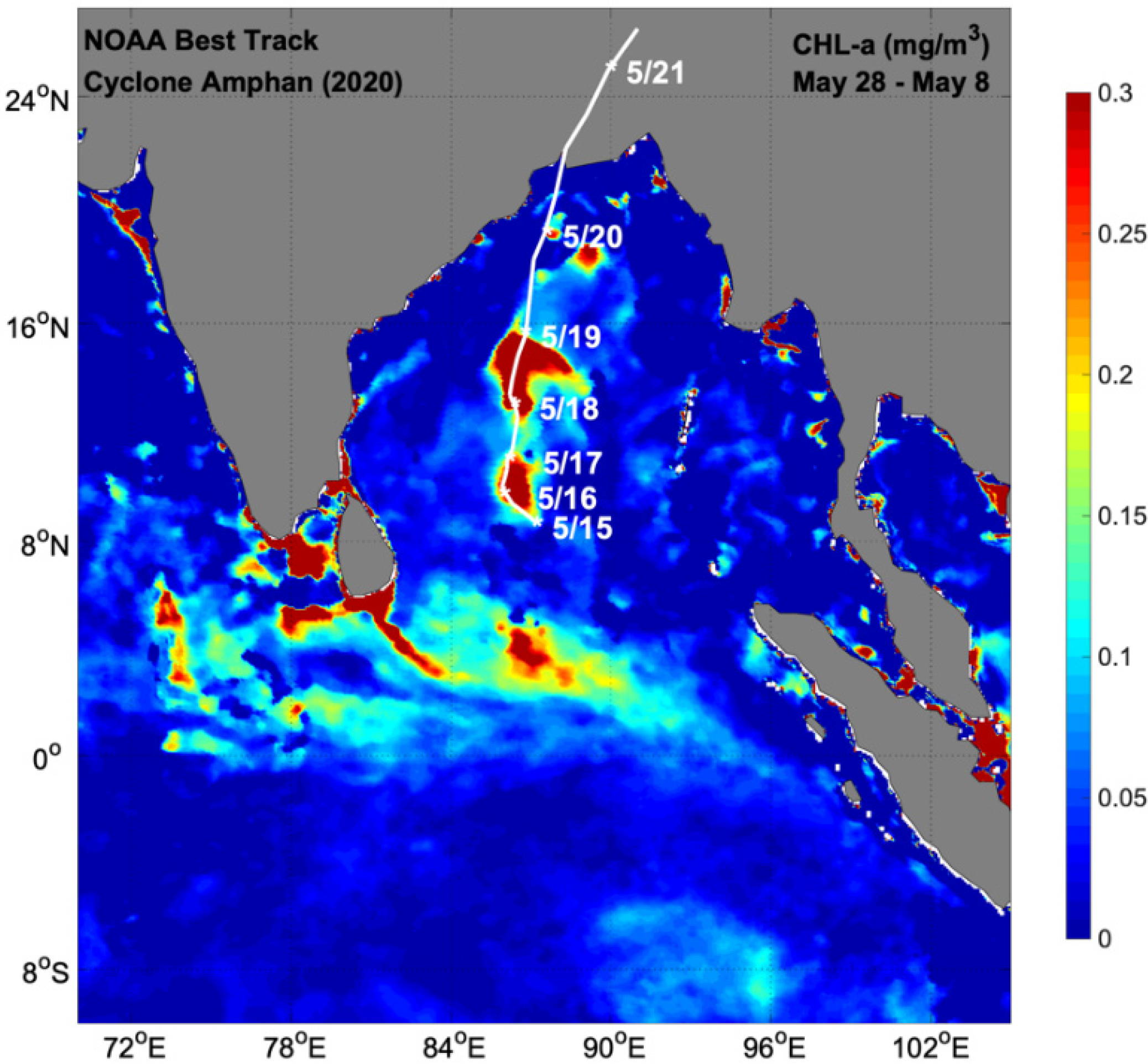
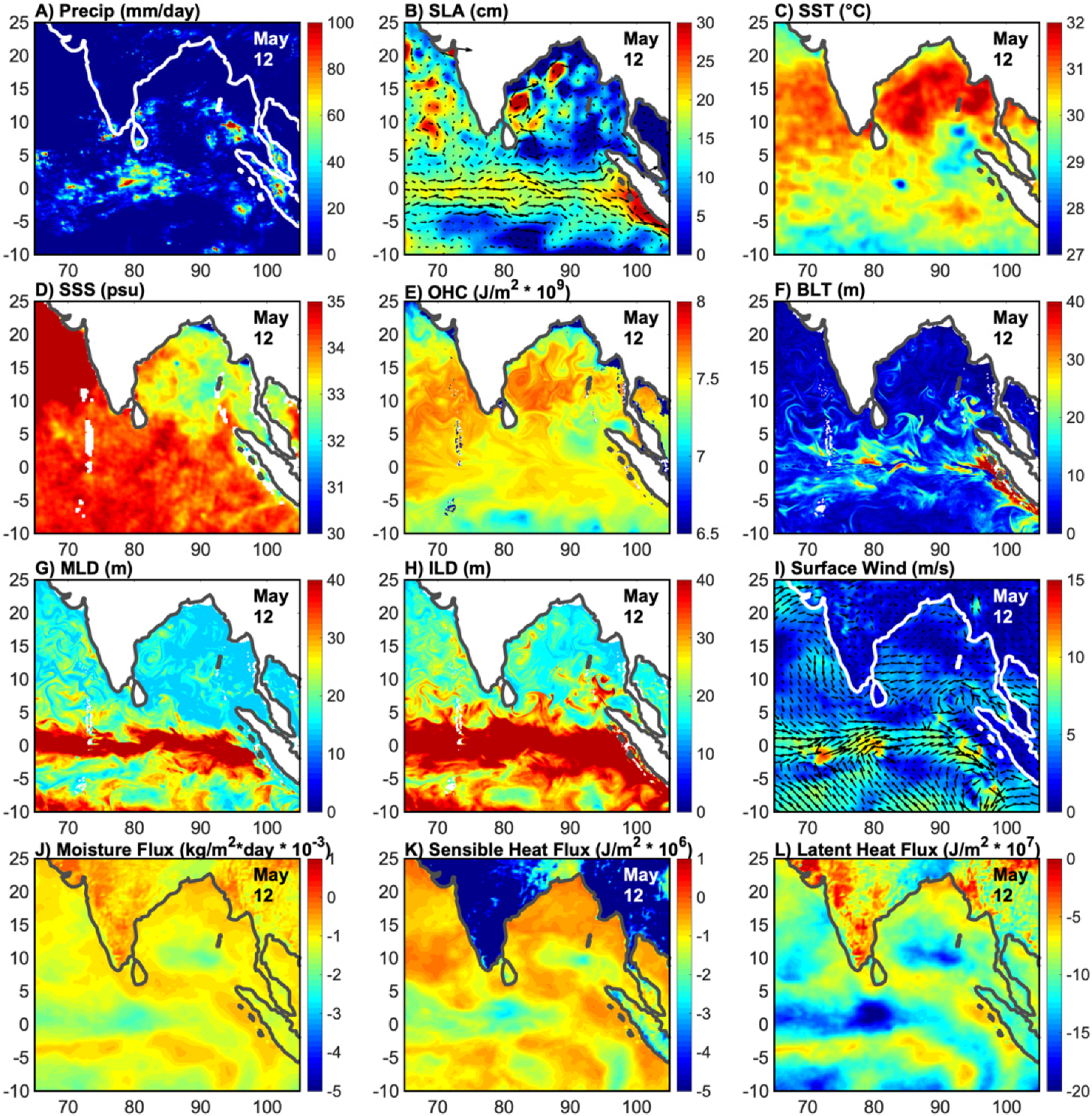
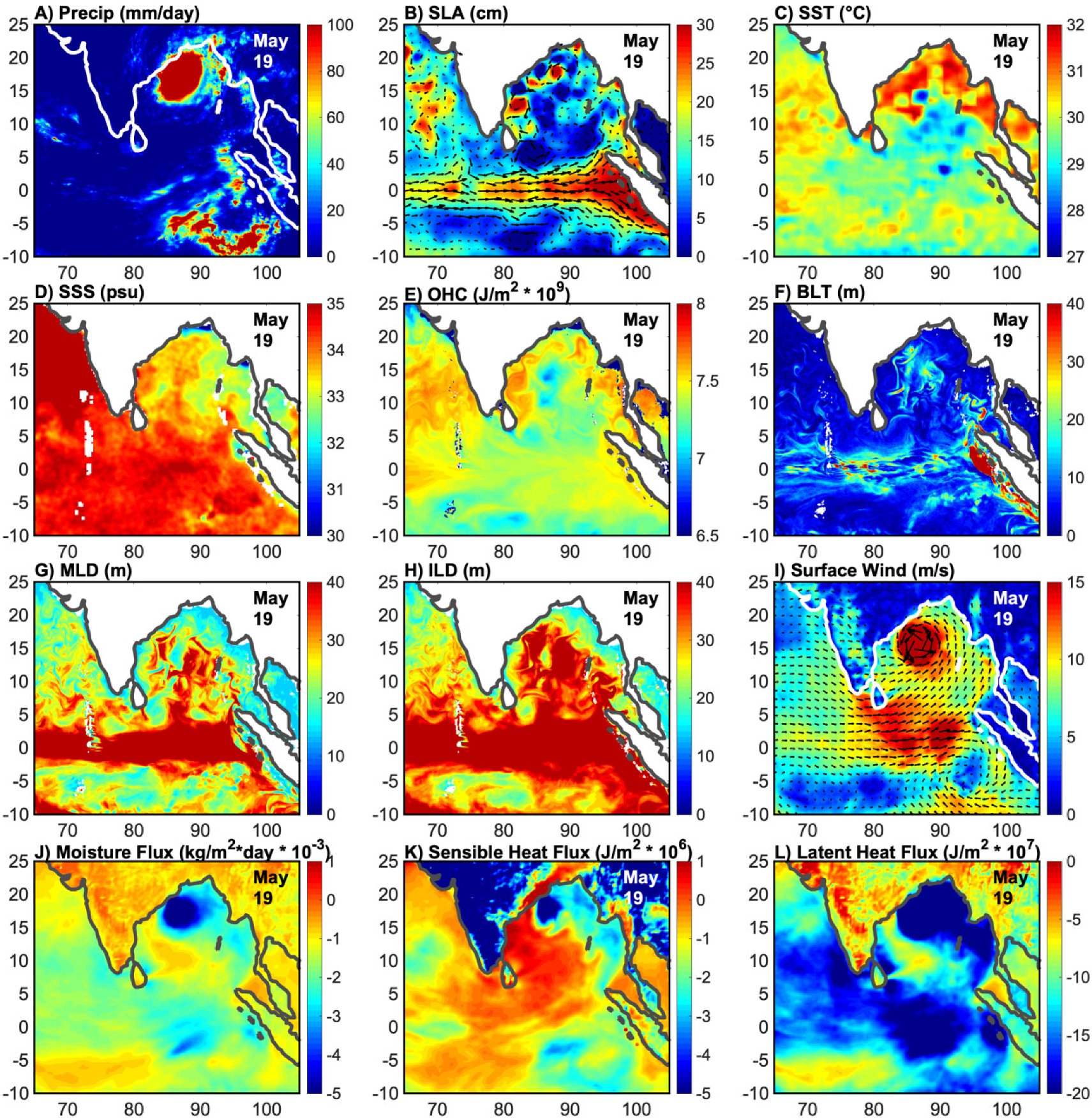
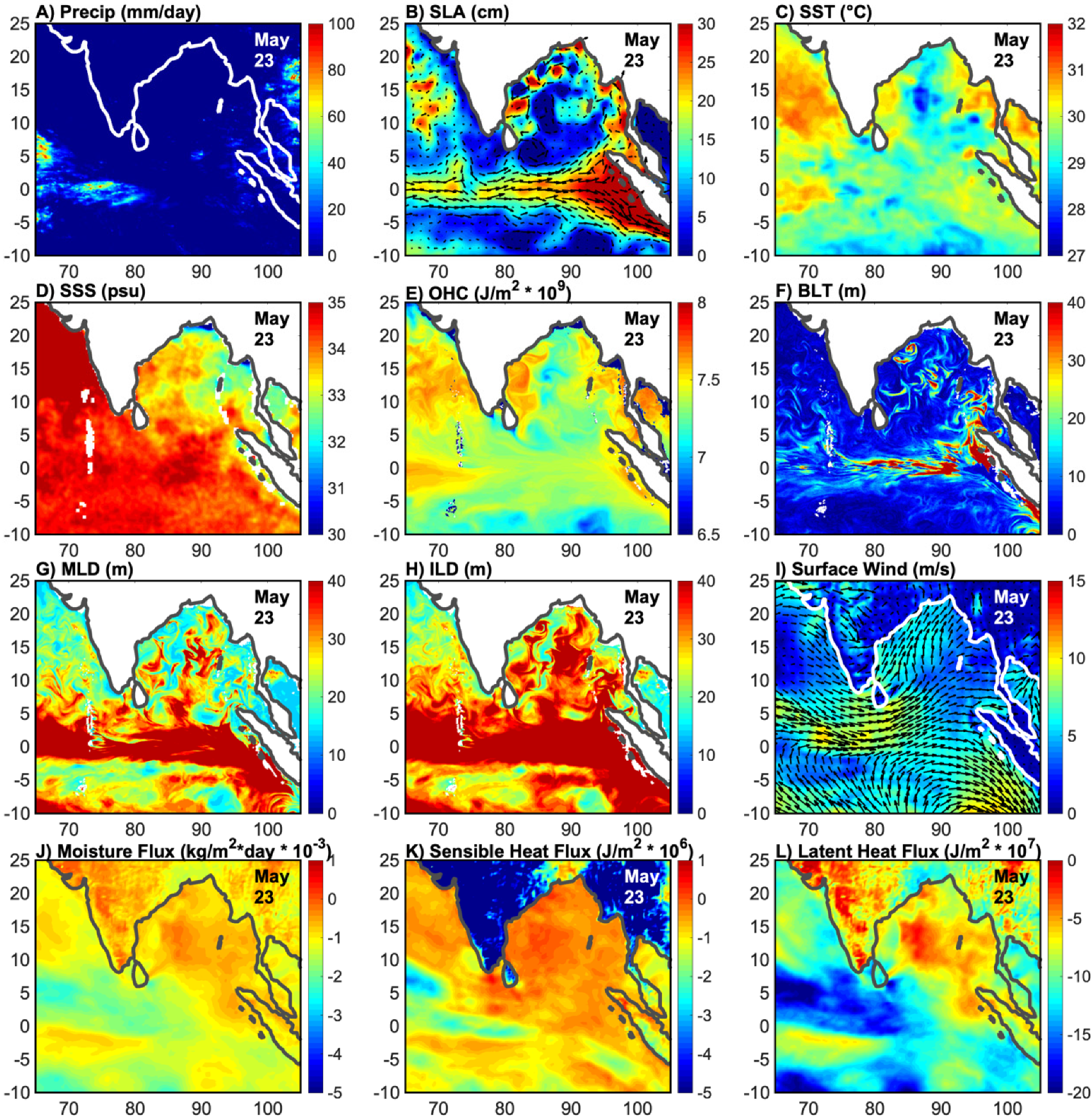
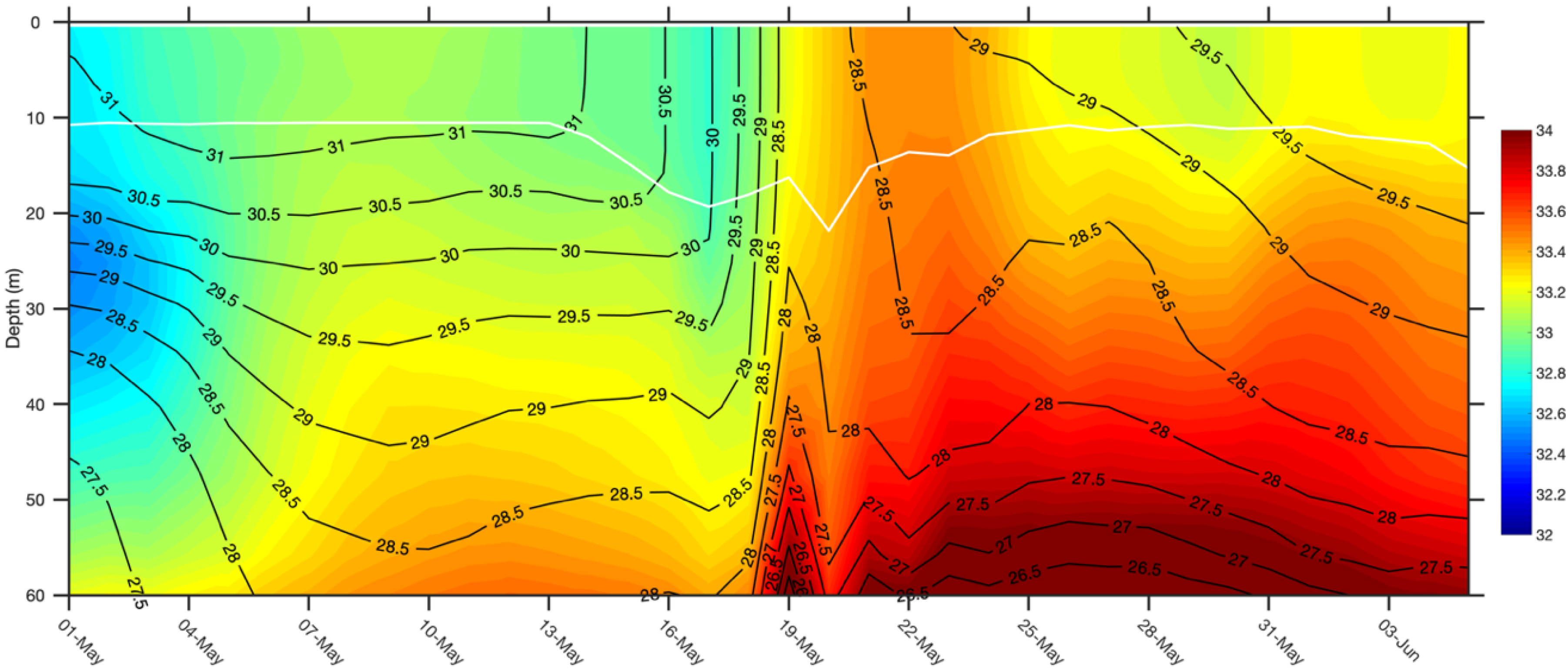
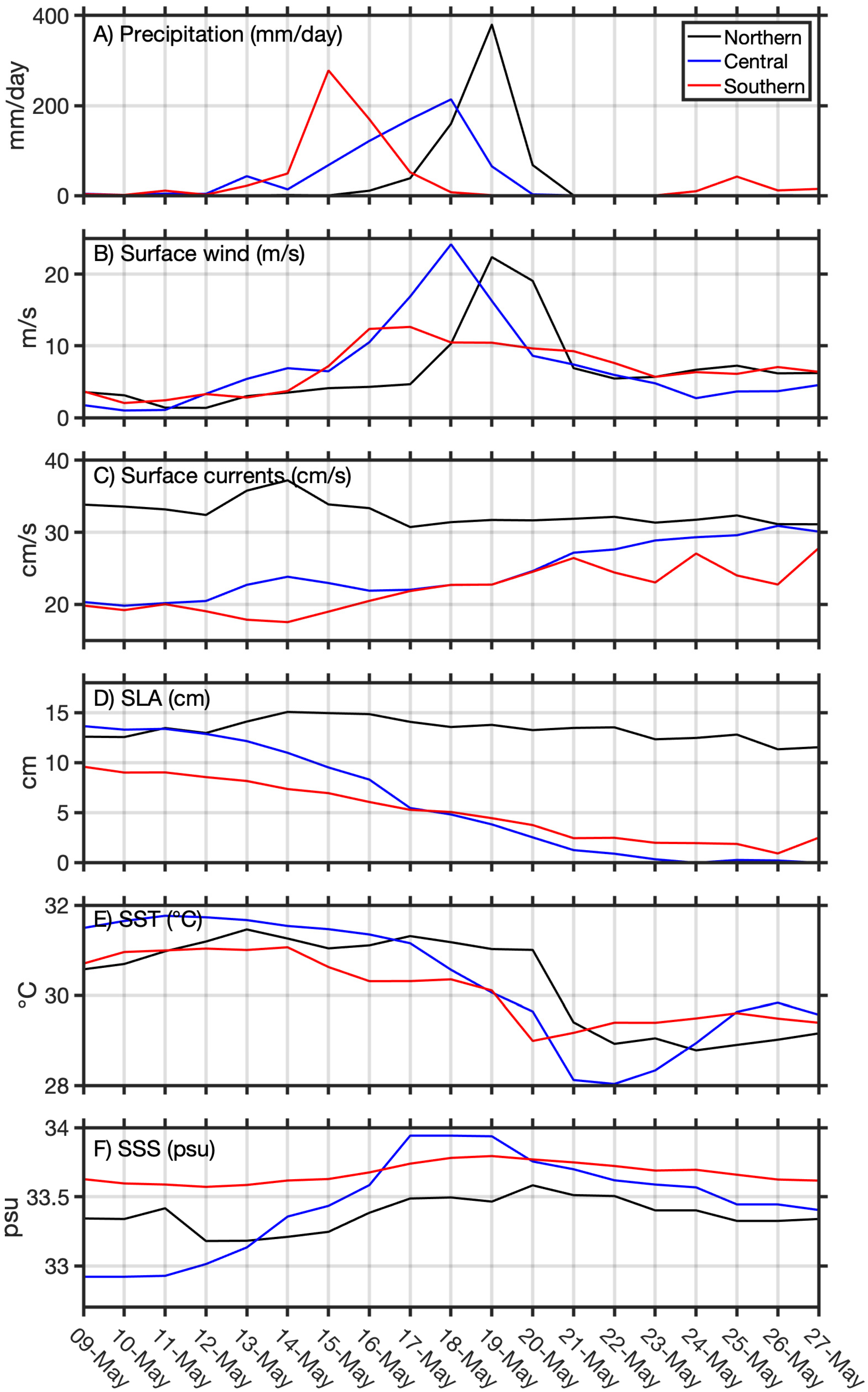
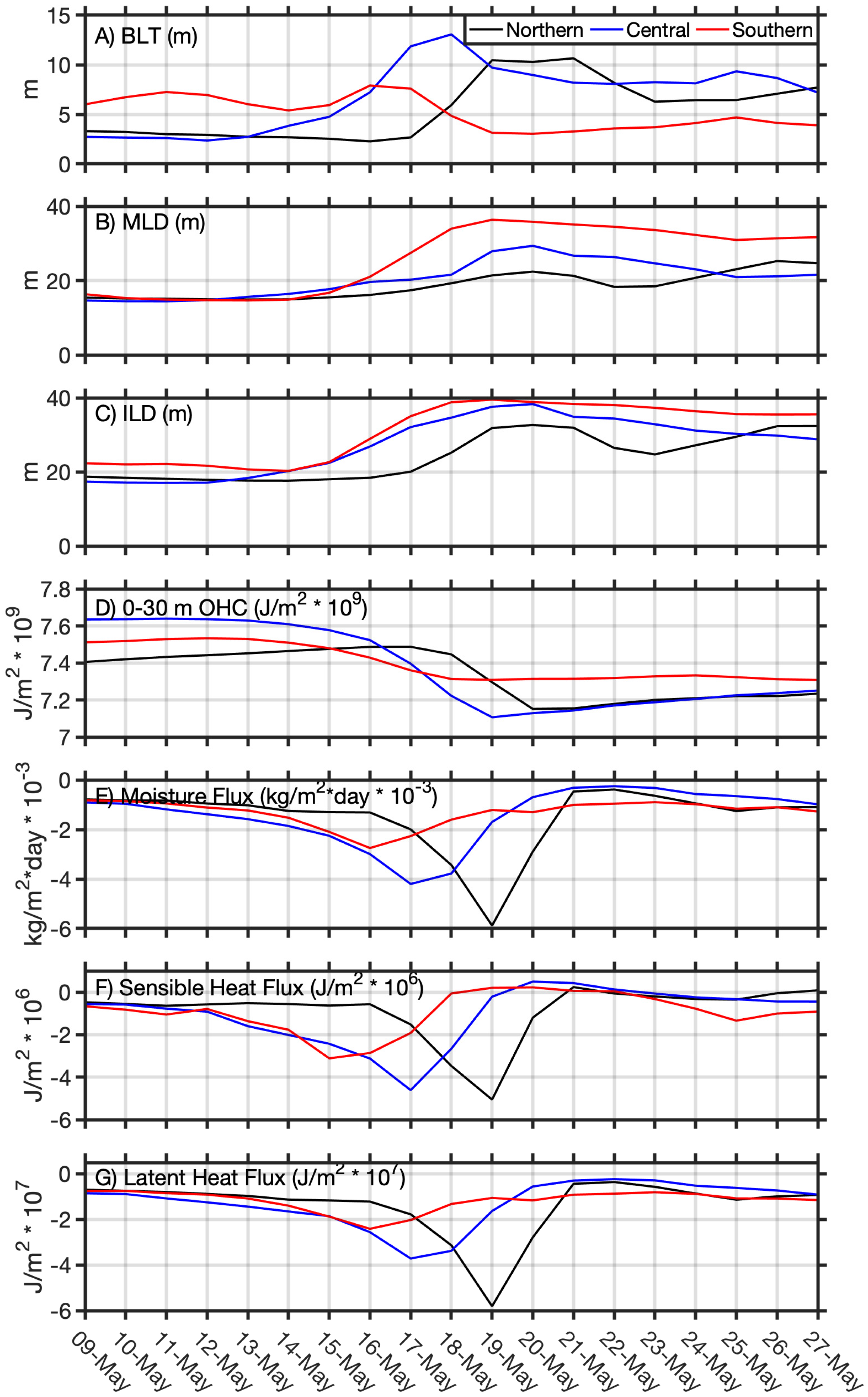
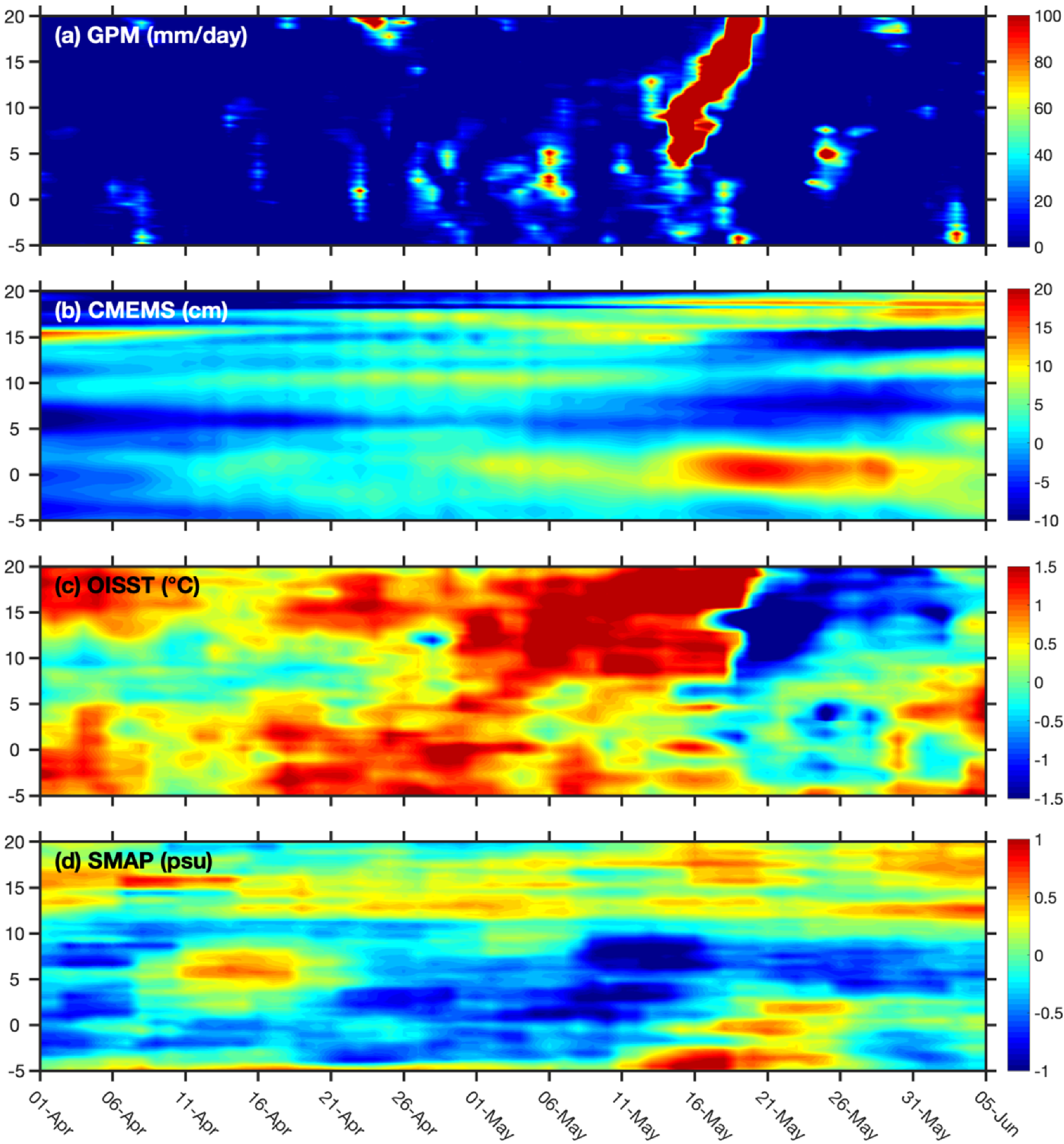
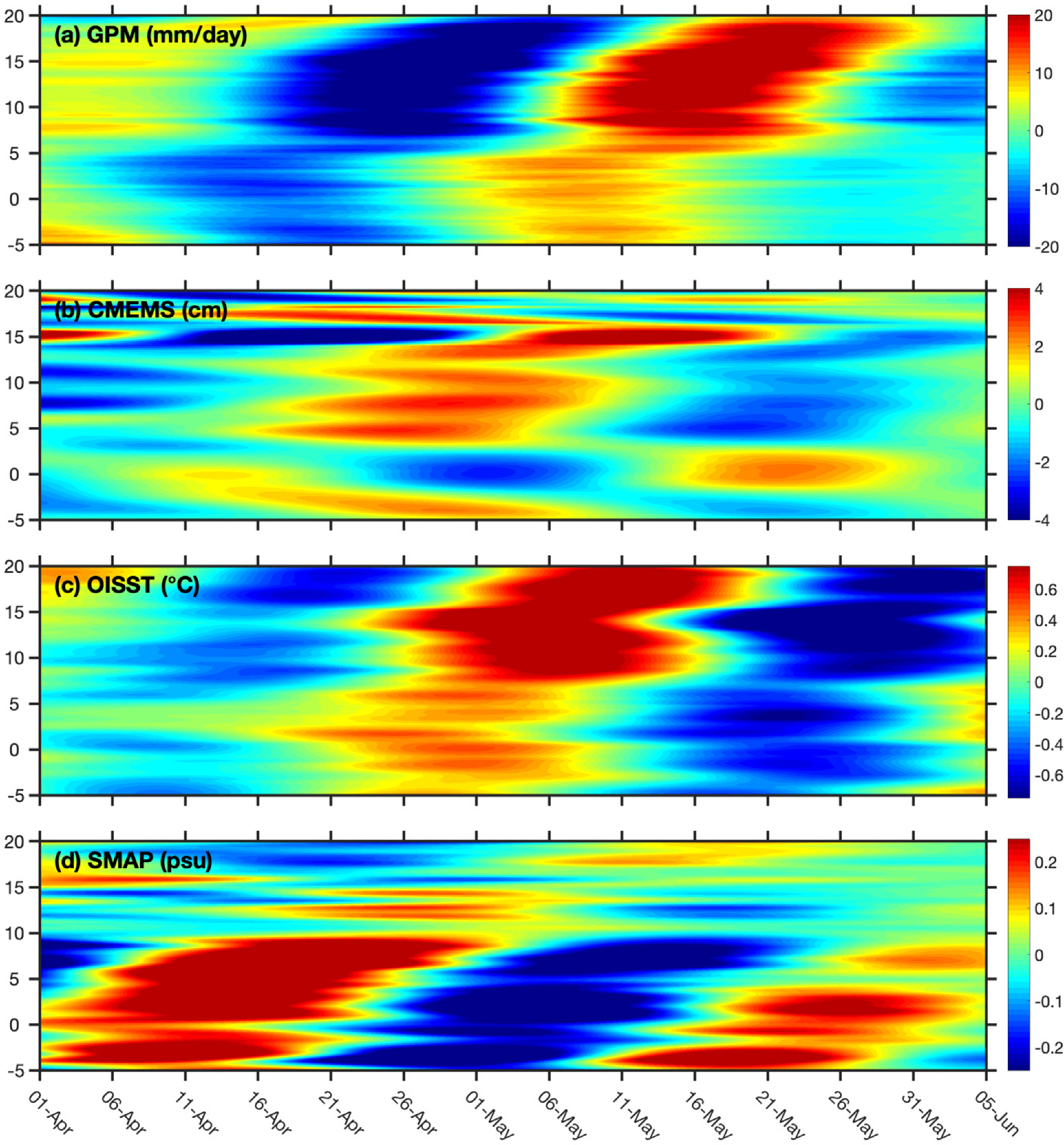
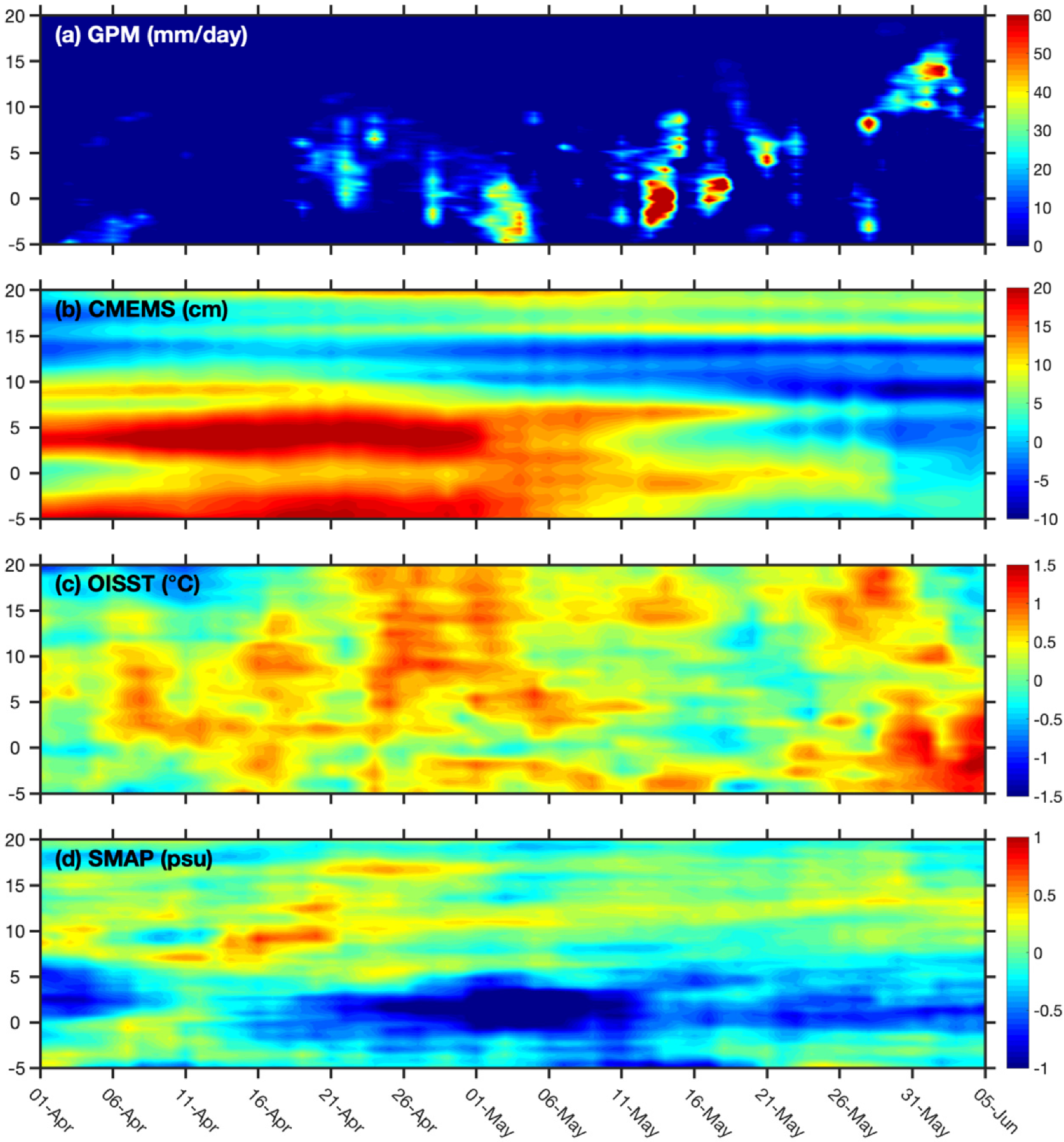
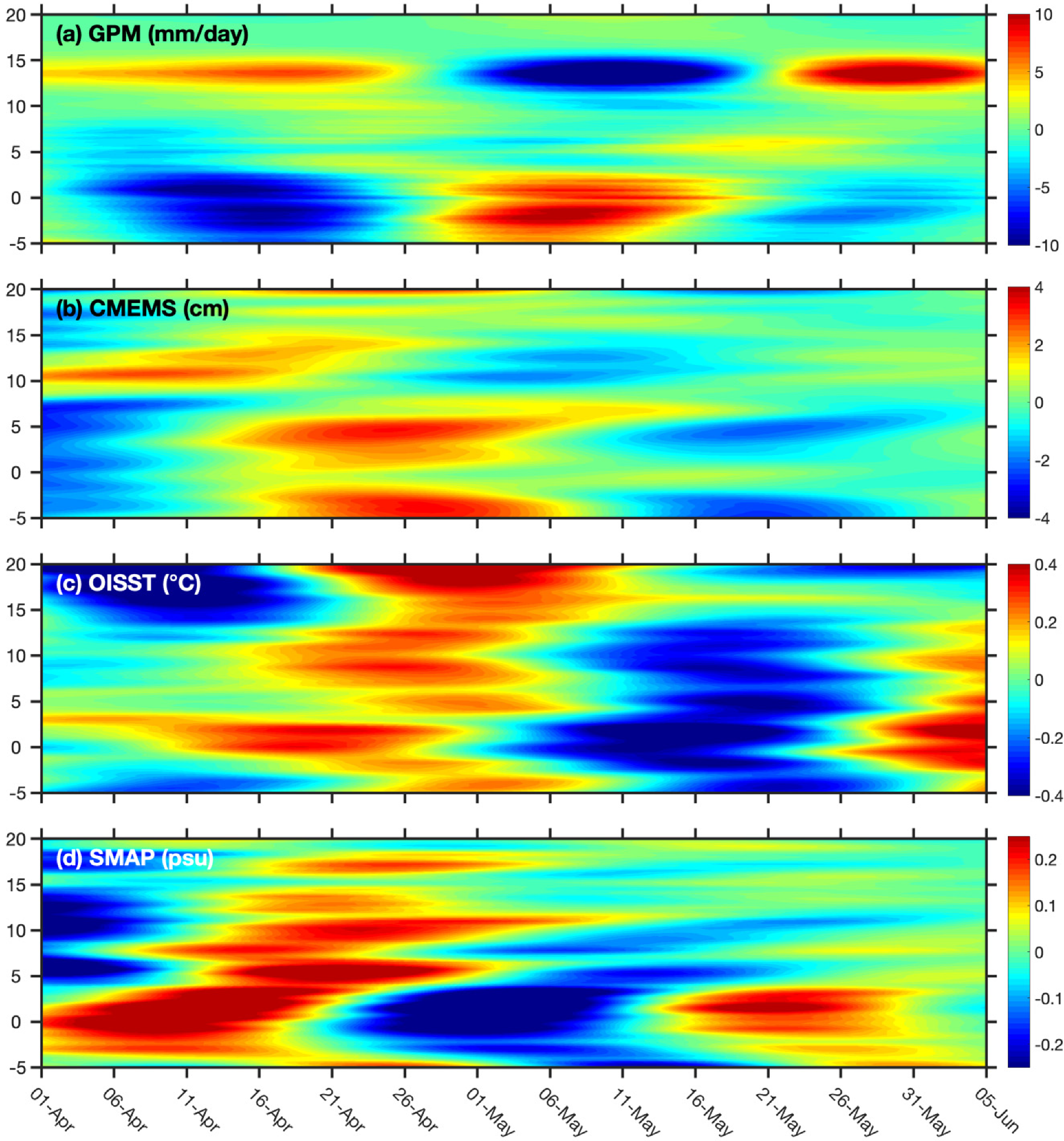
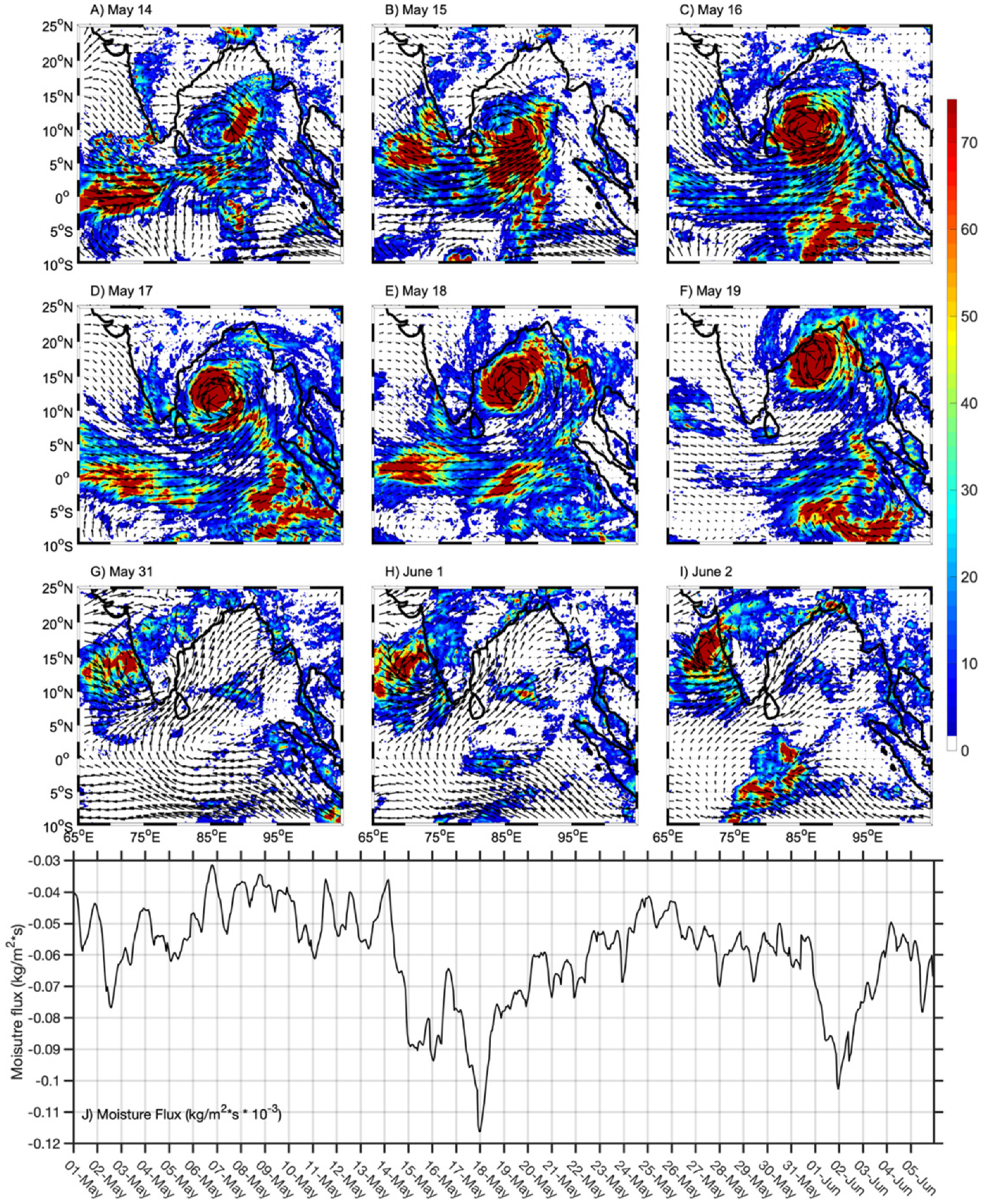
© 2020 by the authors. Licensee MDPI, Basel, Switzerland. This article is an open access article distributed under the terms and conditions of the Creative Commons Attribution (CC BY) license (http://creativecommons.org/licenses/by/4.0/).
Share and Cite
Roman-Stork, H.L.; Subrahmanyam, B. The Impact of the Madden–Julian Oscillation on Cyclone Amphan (2020) and Southwest Monsoon Onset. Remote Sens. 2020, 12, 3011. https://doi.org/10.3390/rs12183011
Roman-Stork HL, Subrahmanyam B. The Impact of the Madden–Julian Oscillation on Cyclone Amphan (2020) and Southwest Monsoon Onset. Remote Sensing. 2020; 12(18):3011. https://doi.org/10.3390/rs12183011
Chicago/Turabian StyleRoman-Stork, Heather L., and Bulusu Subrahmanyam. 2020. "The Impact of the Madden–Julian Oscillation on Cyclone Amphan (2020) and Southwest Monsoon Onset" Remote Sensing 12, no. 18: 3011. https://doi.org/10.3390/rs12183011
APA StyleRoman-Stork, H. L., & Subrahmanyam, B. (2020). The Impact of the Madden–Julian Oscillation on Cyclone Amphan (2020) and Southwest Monsoon Onset. Remote Sensing, 12(18), 3011. https://doi.org/10.3390/rs12183011





